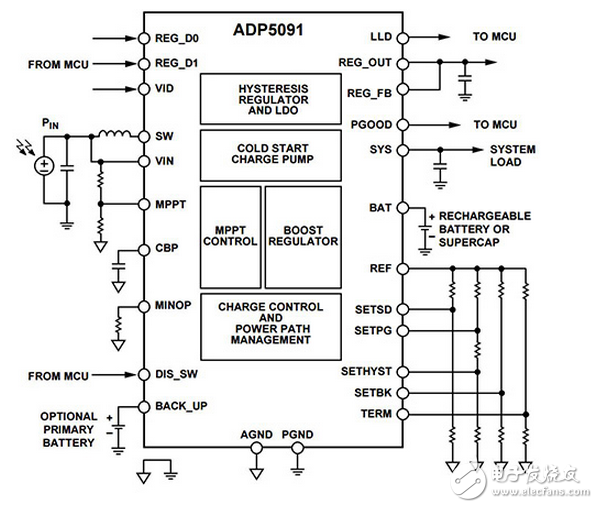
资料下载

智能城市无线传感器网络能量采集功率管理
智能城市无线传感器网络能量采集功率管理
城市是物联网的完美环境。传感器可以被用来提供有用的数据,为许多不同的应用程序,和相对较小的数据包意味着无线链路的比特率可以被交易掉,用于低功耗。这是至关重要的网络与成千上万甚至数百万的节点。世界各地的项目都在寻找从环境中获取能量来获取这些传感器节点的方法。太阳能,热,振动,甚至射频能量都被评估为动力源。
这不同于长距离广域网络,如蜂窝,需要覆盖传感器,可以部署在许多英里。这里的能量要求的无线链路往往可以排除使用能源收集源。
相反,城市的节点可以使用一系列不同的低功耗无线协议从亚GHz的低功耗远程网络(lpwan)到2.4 GHz的智能蓝牙和ZigBee技术以及专有的网状网络。

As the energy harvesting sources have variable, low currents, there are highly specialized requirements for the power management unit (PMU) in order to provide the wireless transceiver, microcontroller, and sensor with power.
Despite increasing integration in the PMU, the design of the energy harvesting power supply for such wireless nodes requires attention to the capacitors and inductors to deliver the optimum power.
The Analog Devices ADP5091 PMU can be used to convert DC power in the 6 µW to 600 mW range to cope with the variations from photovoltaic (PV) cells or thermal energy generators (TEGs) for wireless sensor nodes. These devices charge storage elements such as rechargeable Li-Ion batteries, thin film batteries, supercapacitors, or conventional capacitors to provide a steady current for the sensors. This can also supply the higher power required for the transceiver to send the data to a local gateway.
A key element of the design is an internal cold start circuit so that the regulator can start operating at an input voltage as low as 380 mV. After cold startup, the regulator can handle an input voltage range of 0.08 V to 3.3 V and an additional 150 mA regulated output can be programmed by an external resistor divider or the VID pin in Figure 1.
声明:本文内容及配图由入驻作者撰写或者入驻合作网站授权转载。文章观点仅代表作者本人,不代表电子发烧友网立场。文章及其配图仅供工程师学习之用,如有内容侵权或者其他违规问题,请联系本站处理。 举报投诉
- 相关下载
- 相关文章






